Papers by Mary K Gospodarowicz
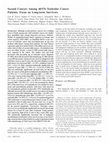
JNCI: Journal of the National Cancer Institute, 2005
Background: Although second primary cancers are a leading cause of death among men with testicula... more Background: Although second primary cancers are a leading cause of death among men with testicular cancer, few studies have quantifi ed risks among long-term survivors. Methods: Within 14 population-based tumor registries in Europe and North America (1943-2001), we identifi ed 40 576 1-year survivors of testicular cancer and ascertained data on any new incident solid tumors among these patients. We used Poisson regression analysis to model relative risks (RRs) and excess absolute risks (EARs) of second solid cancers. All statistical tests were two-sided. Results: A total of 2285 second solid cancers were reported in the cohort. The relative risk and EAR decreased with increasing age at testicular cancer diagnosis (P <.001); the EAR increased with attained age (P <.001) but the excess RR decreased. Among 10-year survivors diagnosed with testicular cancer at age 35 years, the risk of developing a second solid tumor was increased (RR = 1.9, 95% confi dence interval [CI] = 1.8 to 2.1). Risk remained statistically signifi cantly elevated for 35 years (RR = 1.7, 95% CI = 1.5 to 2.0; P <.001). We observed statistically signifi cantly elevated risks, for the fi rst time, for cancers of the pleura (malignant mesothelioma; RR = 3.4, 95% CI = 1.7 to 5.9) and esophagus (RR = 1.7, 95% CI = 1.0 to 2.6). Cancers of the lung (RR = 1.5, 95% CI = 1.2 to 1.7), colon (RR = 2.0, 95% CI = 1.7 to 2.5), bladder (RR = 2.7, 95% CI = 2.2 to 3.1), pancreas (RR = 3.6, 95% CI = 2.8 to 4.6), and stomach (RR = 4.0, 95% CI = 3.2 to 4.8) accounted for almost 60% of the total excess. Overall patterns were similar for seminoma and nonseminoma patients, with lower risks observed for nonseminoma patients treated after 1975. Statistically signifi cantly increased risks of solid cancers were observed among patients treated with radiotherapy alone (RR = 2.0, 95% CI = 1.9 to 2.2), chemotherapy alone (RR = 1.8, 95% CI = 1.3 to 2.5), and both (RR = 2.9, 95% CI = 1.9 to 4.2). For patients diagnosed with seminomas or nonseminomatous tumors at age 35 years, cumulative risks of solid cancer 40 years later (i.e., to age 75 years) were 36% and 31%, respectively, compared with 23% for the general population. Conclusions : Testicular cancer survivors are at statistically signifi cantly increased risk of solid tumors for at least 35 years after treatment. Young patients may experience high levels of risk as they reach older ages. The statistically signifi cantly increased risk of malignant mesothelioma in testicular cancer survivors has, to our knowledge, not been observed previously in a cohort of patients treated with radiotherapy. [
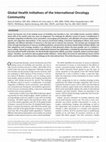
American Society of Clinical Oncology educational book. American Society of Clinical Oncology. Meeting, 2017
Cancer has become one of the leading causes of morbidity and mortality in low- and middle-income ... more Cancer has become one of the leading causes of morbidity and mortality in low- and middle-income countries (LMICs), where 60% of the world's total new cases are diagnosed. The challenge for effective control of cancer is multifaceted. It mandates integration of effective cancer prevention, encouraging early detection, and utilization of resource-adapted therapeutic and supportive interventions. In the resource-constrained setting, it becomes challenging to deliver each service optimally, and efficient allocation of resources is the best way to improve the outcome. This concept was translated into action through development of resource-stratified guidelines, pioneered by the Breast Health Global Initiative (BHGI), and later adopted by most oncology societies in an attempt to help physicians deliver the best possible care in a limited-resource setting. Improving outcome entails collaboration between key stakeholders, including the pharmaceutical industry, local and national health...
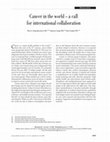
Salud Pública de México, 2009
Cancer in the world Artículo especiAl C ancer is a major health problem in the world. 1-3 Since t... more Cancer in the world Artículo especiAl C ancer is a major health problem in the world. 1-3 Since the start of the 21 st century, cancer killed more people than died in World War II. This year, it is expected that there will be 12 million new cancer cases diagnosed and close to 8 million will die of cancer. This year it is expected that 1.4 million people will die from lung cancer with 866 000 from stomach cancer, 653 000 from liver cancer, 677 000 from colon cancer and over half a million, 548 000 deaths will be due to breast cancer. Today, a new breast cancer case in diagnosed in the world approximately every 25 seconds. It is estimated that by the year 2030, 12 million people will die each year if we do not act today and improve cancer control. At the same time our knowledge about cancer has never been greater. These statistics are a call for action. International collaboration across all sectors is needed to improve cancer control and reverse the trend. Cancer arises from a change in one single cell and that change may be started by external agents and inherited genetic factors. Today, it is known that tobacco is the single most important external agent causing cancer. 4 Almost 70% of all deaths in the world from cancer occur in the low-and middle-income countries. 1 It is expected that 43% of cancer deaths be due to tobacco, poor diet, and infection. While over 40% of all cancers in the Western world are due to tobacco consumption and poor
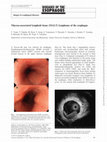
Diseases of the Esophagus, 2012
A 70-year-old man was referred for dysphagia. Esophagogastroduodenoscopy (EGD) revealed a submuco... more A 70-year-old man was referred for dysphagia. Esophagogastroduodenoscopy (EGD) revealed a submucosal tumor (SMT) covered with smooth normal mucosa in the upper thoracic esophagus (Fig. 1a). The lesion had a longitudinal concave elevation and circumscribed about half around. Endoscopic ultrasonography showed an isoechoic homogeneous mass located in the second to third layer (Fig. 2). Computed tomography (CT) showed 5-cm esophageal wall thickness in the lesion along and swelled multiple mediastinal lymph nodes. The biopsy tissue showed aggregation of small lymphocytes in subepithelial area (Fig. 3), which were immunohistochemically positive for CD20 and negative for CD10, CD23, and cyclin D1. Rearrangement of immunoglobulin heavy-chain joining region genes was found. Based on those findings, we diagnosed extranodal marginal zone lymphoma of mucosa-associated lymphoid tissue (MALT) type of the esophagus. After eradication of Helicobacter pylori, he was treated with rituximab (375 mg/m 2).
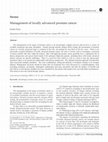
Asian Journal of Andrology, 2008
The management of all stages of prostate cancer is an increasingly complex process and involves a... more The management of all stages of prostate cancer is an increasingly complex process and involves a variety of available treatments and many disciplines. Despite prostate-specific antigen (PSA) testing, the presentation of prostate cancer at a locally advanced stage is common in the UK, accounting for one-third of all new cases. There is no universally accepted definition of locally advanced prostate cancer; the term is loosely used to encompass a spectrum of disease profiles that show high-risk features. Men with high-risk prostate cancer generally have a significant risk of disease progression and cancer-related death if left untreated. High-risk patients, including those with locally advanced disease, present two specific challenges. There is a need for local control as well as a need to treat any microscopic metastases likely to be present but undetectable until disease progression. The optimal treatment approach will therefore often necessitate multiple modalities. The exact combinations, timing and intensity of treatment continue to be strongly debated. Management decisions should be made after all treatments have been discussed by a multidisciplinary team (including urologists, oncologists, radiologists, pathologists and nurse specialists) and after the balance of benefits and side effects of each therapy modality has been considered by the patient with regard to his own individual circumstances. This article reviews the current therapy options.
British Journal of Haematology, Jan 29, 2013
There is a lack of contemporary prospective data examining the ABVD (adriamycin, bleomycin, vinbl... more There is a lack of contemporary prospective data examining the ABVD (adriamycin, bleomycin, vinblastine, dacarbazine) and Stanford V (SV; doxorubicin, vinblastine, mechlorethamine, vincristine, bleomycin, etoposide, prednisone) regimens in older Hodgkin lymphoma (HL) patients. Forty-four advanced-stage, older HL patients (aged ≥60 years) were treated on the
Cancer survivors constitute 3.5 % of the United States popu-lation, but second primary malignanci... more Cancer survivors constitute 3.5 % of the United States popu-lation, but second primary malignancies among this high-risk group now account for 16 % of all cancer incidence. Although few data currently exist regarding the molecular mechanisms for second primary cancers and other late outcomes after cancer treatment, the careful measurement and documenta-tion of potentially carcinogenic treatments (chemotherapy and radiotherapy) provide a unique platform for in vivo research on gene – environment interactions in human car-cinogenesis. We review research priorities identifi ed during a National Cancer Institute (NCI) – sponsored workshop entitled “ Cancer Survivorship — Genetic Susceptibility and Second Primary Cancers. ” These priorities include 1) devel-opment of a national research infrastructure for studies of cancer survivorship; 2) creation of a coordinated system for
The Lancet Global Health, 2018
Annals of Palliative Medicine, 2019
Radiotherapy is an essential component of cancer therapy. Lack of access to radiotherapy in lessd... more Radiotherapy is an essential component of cancer therapy. Lack of access to radiotherapy in lessdeveloped countries prevents its use for both cure and symptom relief, resulting in a significant disparity in patient suffering. Several recent initiatives have highlighted the need for expanded access to both palliative medicine and radiotherapy globally. Yet, these efforts have remained largely independent, without attention to overlap and integration. This review provides an update on the progress toward global palliative radiotherapy access and proposes a strategic framework to address further scale-up. Synergies between radiotherapy, palliative medicine, and other global health initiatives will be essential in bringing palliative radiotherapy to patients around the globe.
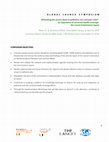
Lancet (London, England), Apr 11, 2017
SYMPOSIUM OBJECTIVES • Convene experts across various disciplines including global health, health... more SYMPOSIUM OBJECTIVES • Convene experts across various disciplines including global health, health systems and palliative care to disseminate and discuss the evidence base and findings of the seminal report of the Lancet Commission on Global Access to Palliative Care and Pain Relief. • Review and catalyze the research and implementation agenda resulting from the recommendations of the Commission's report. • Identify opportunities and future directions for regional and global collective action to achieve universal access to palliative care. • Strengthen the work of the Commission´s Implementation Group and help develop concrete next steps for action. • Contribute to building a platform for knowledge-exchange on lessons for scale-up and integration of palliative care into universal health coverage efforts. • Through the Implementation Workshops that will take place on April 6 th in the afternoon, contribute to national planning and develop specific projects.
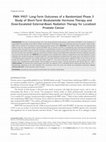
Cancer, Jan 24, 2016
The role of hormone therapy (HT) with dose-escalated external-beam radiotherapy (DE-EBRT) in the ... more The role of hormone therapy (HT) with dose-escalated external-beam radiotherapy (DE-EBRT) in the treatment of intermediate-risk prostate cancer (IRPC) remains controversial. The authors report the long-term outcome of a phase 3 study of DE-EBRT with or without HT for patients with localized prostate cancer (LPC). From 1999 to 2006, 252 of an intended 338 patients with LPC were randomized to receive DE-EBRT with or without 5 months of neoadjuvant and concurrent bicalutamide 150 mg once daily. The study was closed early because of contemporary concerns surrounding bicalutamide. The primary outcome was biochemical failure (BF) incidence, and the secondary endpoints were overall survival (OS), local control (LC), and quality of life. The BF and OS rates were estimated using the cumulative incidence function and Kaplan-Meier methods and were compared using the Gray test and the log-rank test. Eleven patients were excluded from analysis. Characteristics were well balanced in each treatmen...
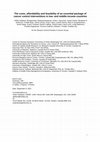
The Lancet, 2016
Investments in cancer control-prevention, detection, diagnosis, surgery, other treatment, and pal... more Investments in cancer control-prevention, detection, diagnosis, surgery, other treatment, and palliative care-are increasingly needed in low-and, particularly, middle-income countries, where most of the world's cancer deaths occur without treatment or palliation. To help countries expand locally appropriate services, Cancer, a volume in the Disease Control Priorities, 3 rd edition series, developed an essential package of potentially cost-effective measures for countries to consider and adapt. Included in the package are: preventing tobacco-related cancer and virus-related liver and cervical cancer; diagnosis and treatment of early breast cancer and cervical cancer and selected childhood cancers; and widespread availability of palliative care, including opioids. These interventions would cost an additional $20 billion per year worldwide, adding 3% to total public spending on health in LMICs. Implementing an appropriately tailored package, most countries could reduce suffering and premature death from cancer substantially before 2030, with even greater improvements in later decades.
Clinical Oncology, 2015
Clinical Oncology j o ur n a l h o m e p a ge : w w w. c l i n i c a l on c o l o gy o n l i ne. ... more Clinical Oncology j o ur n a l h o m e p a ge : w w w. c l i n i c a l on c o l o gy o n l i ne. n e t
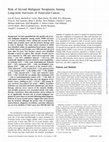
JNCI Journal of the National Cancer Institute, 1997
Background: We have quantified the site-specific risk of second malignant neoplasms among nearly ... more Background: We have quantified the site-specific risk of second malignant neoplasms among nearly 29 000 survivors (у1 year) of testicular cancer, taking into account the histologic type of initial cancer and the primary therapy used to treat it. Methods: The study cohort consisted of 28 843 men identified within 16 population-based tumor registries in North America and Europe; over 3300 men had survived more than 20 years. New invasive cancers were identified through a search of registry files. Results: Second cancers were reported in 1406 men (observed-to-expected ratio [O/E] = 1.43; 95% confidence interval = 1.36-1.51), with statistically significant excesses noted for acute lymphoblastic leukemia (O/E = 5.20), acute nonlymphocytic leukemia (O/E = 3.07), melanoma (O/E = 1.69), non-Hodgkin's lymphoma (O/E = 1.88), and cancers of the stomach (O/E = 1.95), colon (O/E = 1.27), rectum (O/E = 1.41), pancreas (O/E = 2.21), prostate (O/E = 1.26), kidney (O/E = 1.50), bladder (O/E = 2.02), thyroid (O/E = 2.92), and connective tissue (O/E = 3.16). Overall risk was similar after seminomas (O/E = 1.42) or nonseminomatous tumors (O/E = 1.50). Risk of solid tumors increased with time since the diagnosis of testicular cancer, yielding an O/E = 1.54 (O = 369) among 20year survivors (two-sided P for trend = .00002). Secondary leukemia was associated with both radiotherapy and chemotherapy, whereas excess cancers of the stomach, bladder, and, possibly, pancreas were associated mainly with radiotherapy. Conclusions: Men with testicular cancer continue to be at significantly elevated risk of second malignant neoplasms for more than two decades following initial diagnosis. Patterns of excess second cancers suggest that many factors may be involved, although the precise roles of treatment, natural history, diagnostic surveillance, and other influences are yet to be clarified. [
JNCI: Journal of the National Cancer Institute, 2006
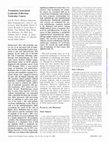
Journal of the National Cancer Institute, 2000
Background: Men with testicular cancer are at an increased risk of leukemia, but the relationship... more Background: Men with testicular cancer are at an increased risk of leukemia, but the relationship to prior treatments is not well characterized. The purpose of our study was to describe the risk of leukemia following radiotherapy and chemotherapy for testicular cancer. Methods: Within a population-based cohort of 18 567 patients diagnosed with testicular cancer (from 1970 through 1993), a case-control study of leukemia was undertaken. Radiation dose to active bone marrow and type and cumulative amount of cytotoxic drugs were compared between 36 men who developed leukemia and 106 matched control patients without leukemia. Conditional logistic regression was used to estimate the relative risk of leukemia associated with specific treatments. All P values are twosided. Results: Radiotherapy (mean dose to active bone marrow, 12.6 Gy) without chemotherapy was associated with a threefold elevated risk of leukemia. Risk increased with increasing dose of radiation to active bone marrow (P for trend = .02), with patients receiving radiotherapy to the chest as well as to the abdominal/pelvic fields accounting for much of the risk at higher doses. Radiation dose to active bone marrow and the cumulative dose of cisplatin (P for trend = .001) were both predictive of excess leukemia risk in a model adjusted for all treatment variables. The estimated relative risk of leukemia at a cumulative dose of 650 mg cisplatin, which is commonly administered in current testicular cancer treatment regimens, was 3.2 (95% confidence interval = 1.5-8.4); larger doses (1000 mg) were linked with statistically
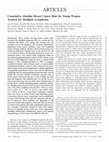
JNCI: Journal of the National Cancer Institute, 2005
Background: Many women develop breast cancer after treatment for Hodgkin lymphoma (HL) at a young... more Background: Many women develop breast cancer after treatment for Hodgkin lymphoma (HL) at a young age. We estimated this future risk, taking into account age and calendar year of HL diagnosis, HL treatment information, population breast cancer incidence rates, and competing causes of death. Methods: Relative risks of breast cancer for categories defi ned by radiation dose to the chest (0, 20-<40 Gy, or ≥ 40 Gy) and use of alkylating agents (yes or no) were estimated from a case-control study conducted within an international population-based cohort of 3817 female 1-year survivors of HL diagnosed at age 30 years or younger from January 1, 1965, through December 31, 1994. To compute cumulative absolute risks of breast cancer, we used modifi ed standardized incidence ratios to relate cohort breast cancer risks to those in the general population, enabling application of population-based breast cancer rates, and we allowed for competing risks by using population-based mortality rates in female HL survivors. Results: Cumulative absolute risks of breast cancer increased with age at end of follow-up, time since HL diagnosis, and radiation dose. For an HL survivor who was treated at age 25 years with a chest radiation dose of at least 40 Gy without alkylating agents, estimated cumulative absolute risks of breast cancer by age 35, 45, and 55 years were 1.4% (95% confi dence interval [CI] = 0.9% to 2.1%), 11.1% (95% CI = 7.4% to 16.3%), and 29.0% (95% CI = 20.2% to 40.1%), respectively. Cumulative absolute risks were lower in women treated with alkylating agents. Conclusions: Breast cancer projections varied considerably by type of HL ther apy, time since HL diagnosis, and age at end of follow-up. These estimates are applicable to HL survivors treated with regimens of the past and can be used to counsel such patients and plan management and preventive strategies. Projections should be used with caution, however, in patients treated with more recent approaches, including limited-fi eld radio therapy and/or ovary-sparing chemotherapy. [

Journal of Clinical Oncology, 2002
PURPOSE: Several management options are available to patients with stage I seminoma, including ad... more PURPOSE: Several management options are available to patients with stage I seminoma, including adjuvant radiotherapy, surveillance, and adjuvant chemotherapy. We performed a pooled analysis of patients from the four largest surveillance studies to better delineate prognostic factors associated with disease progression. PATIENTS AND METHODS: Individual patient data were obtained from each center (Princess Margaret Hospital, Danish Testicular Cancer Study Group, Royal Marsden Hospital, and Royal London Hospital) for 638 patients. Tumor characteristics (size, histologic subtype, invasion of rete testis, and tumor invasion into small vessels [SVI]) as well as age at diagnosis were analyzed for prognostic importance for relapse. RESULTS: With a median follow-up of 7.0 years (range, 0.02 to 17.5 years), 121 relapses were observed for an actuarial 5-year relapse-free rate (RFR) of 82.3%. On univariate analysis, tumor size (RFR: ≤ 4 cm, 87%; > 4 cm, 76%; P = .003), rete testis invasion (...
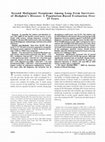
Journal of Clinical Oncology, 2002
PURPOSE: To quantify the relative and absolute excess risks (AER) of site-specific second cancers... more PURPOSE: To quantify the relative and absolute excess risks (AER) of site-specific second cancers, in particular solid tumors, among long-term survivors of Hodgkin’s disease (HD) and to assess risks according to age at HD diagnosis, attained age, and time since initial treatment. PATIENTS AND METHODS: Data from 32,591 HD patients (1,111 25-year survivors) reported to 16 population-based cancer registries in North America and Europe (1935 to 1994) were analyzed. RESULTS: Two thousand one hundred fifty-three second cancers (observed-to-expected ratio [O/E] = 2.3; 95% confidence interval [CI] = 2.2 to 2.4), including 1,726 solid tumors (O/E = 2.0; 95% CI, 1.9 to 2.0) were reported. Cancers of the lung (observed [Obs] = 377; O/E = 2.9), digestive tract (Obs = 376; O/E = 1.7), and female breast (Obs = 234; O/E = 2.0) accounted for the largest number of subsequent malignancies. Twenty-five years after HD diagnosis, the actuarial risk of developing a solid tumor was 21.9%. The relative ris...
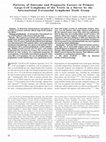
Journal of Clinical Oncology, 2003
Purpose: To determine clinical features and patterns of outcome of primary testicular diffuse lar... more Purpose: To determine clinical features and patterns of outcome of primary testicular diffuse large B-cell lymphomas (DLCL). Patients and Methods: A retrospective international survey of 373 patients with primary testicular DLCL. Results: Most patients presented with localized disease (stage I to II), and the median age at diagnosis was 66 years (range, 19 to 91 years). Anthracycline-based chemotherapy was administered to 255 patients (68%), and prophylactic intrathecal chemotherapy was given to 68 patients (18%); 133 patients (36%) received prophylactic scrotal radiotherapy. Median overall survival was 4.8 years, and median progression-free survival was 4 years. The survival curves showed no clear evidence of a substantial proportion of cured patients. A favorable international prognostic index score (IPI), no B-symptoms, the use of anthracyclines, and prophylactic scrotal radiotherapy were significantly associated with longer survival at multivariate analysis. However, even for pa...










Uploads
Papers by Mary K Gospodarowicz